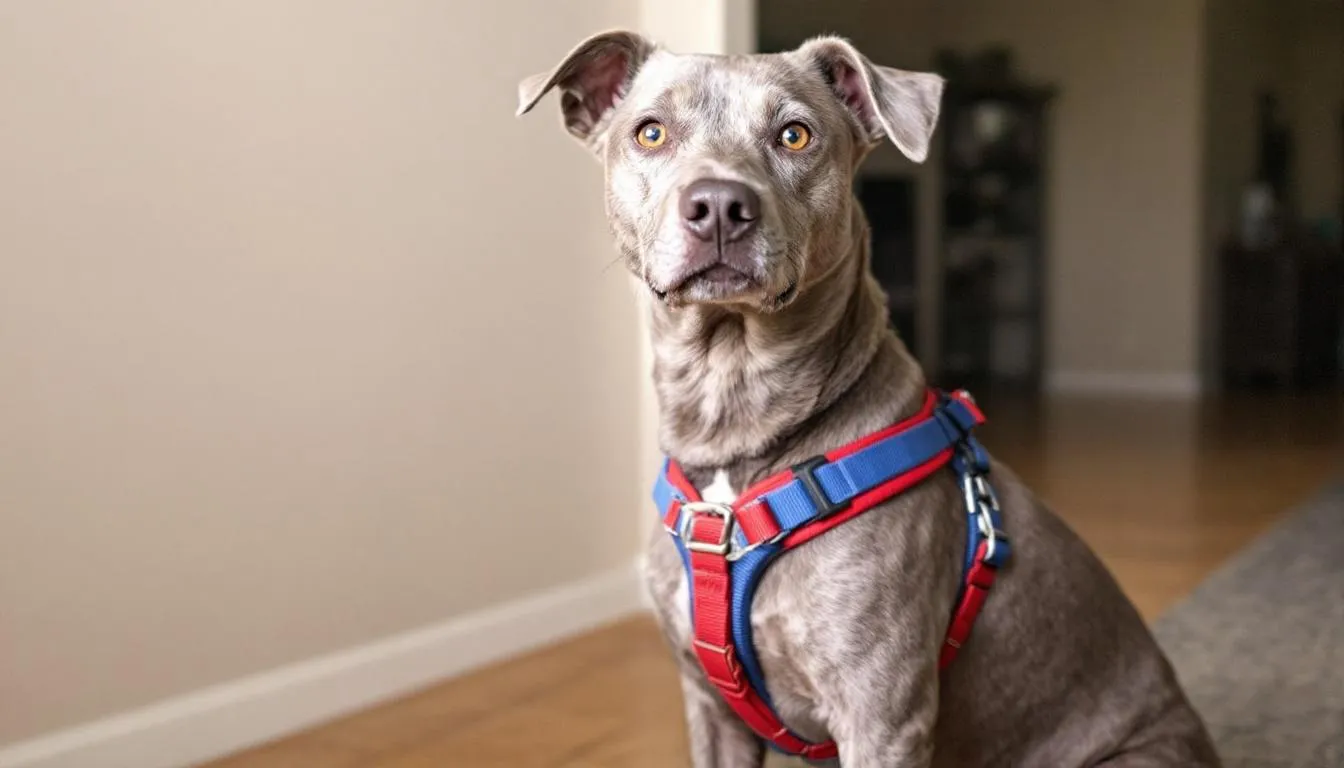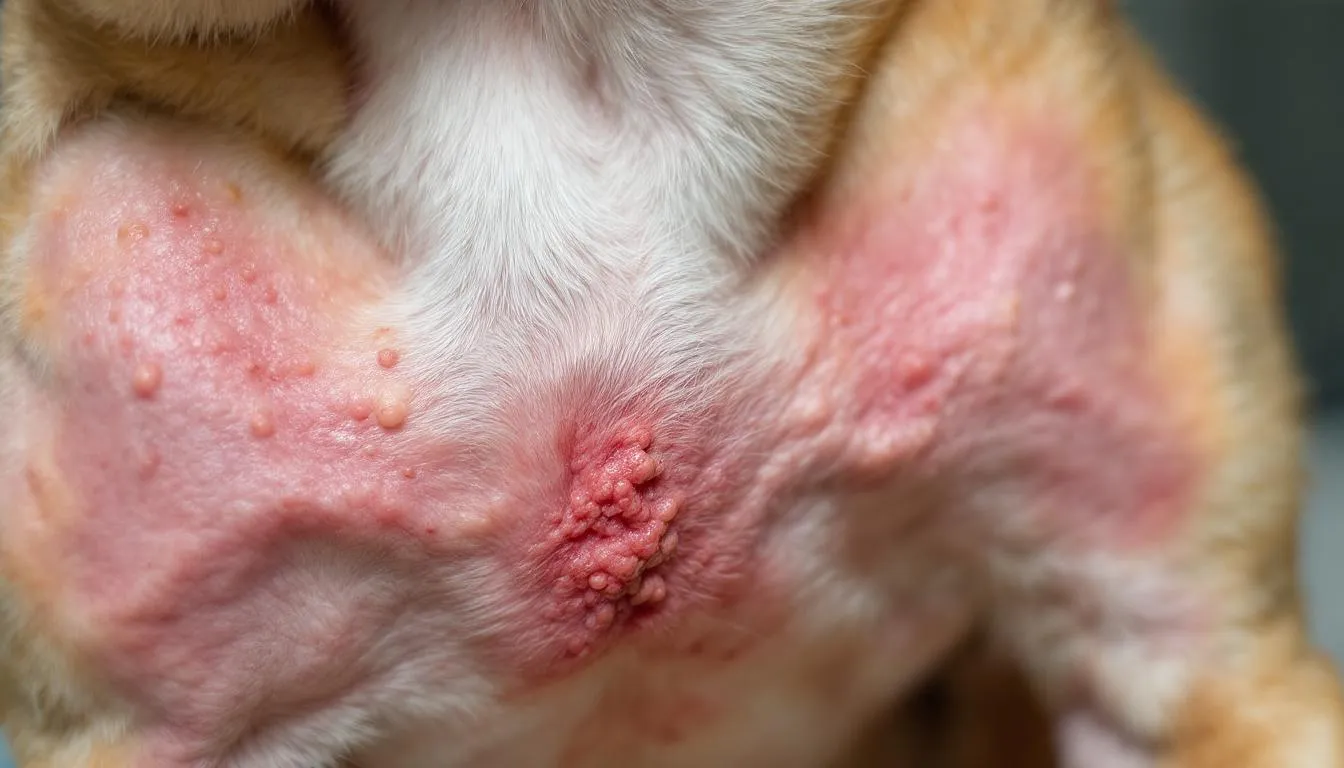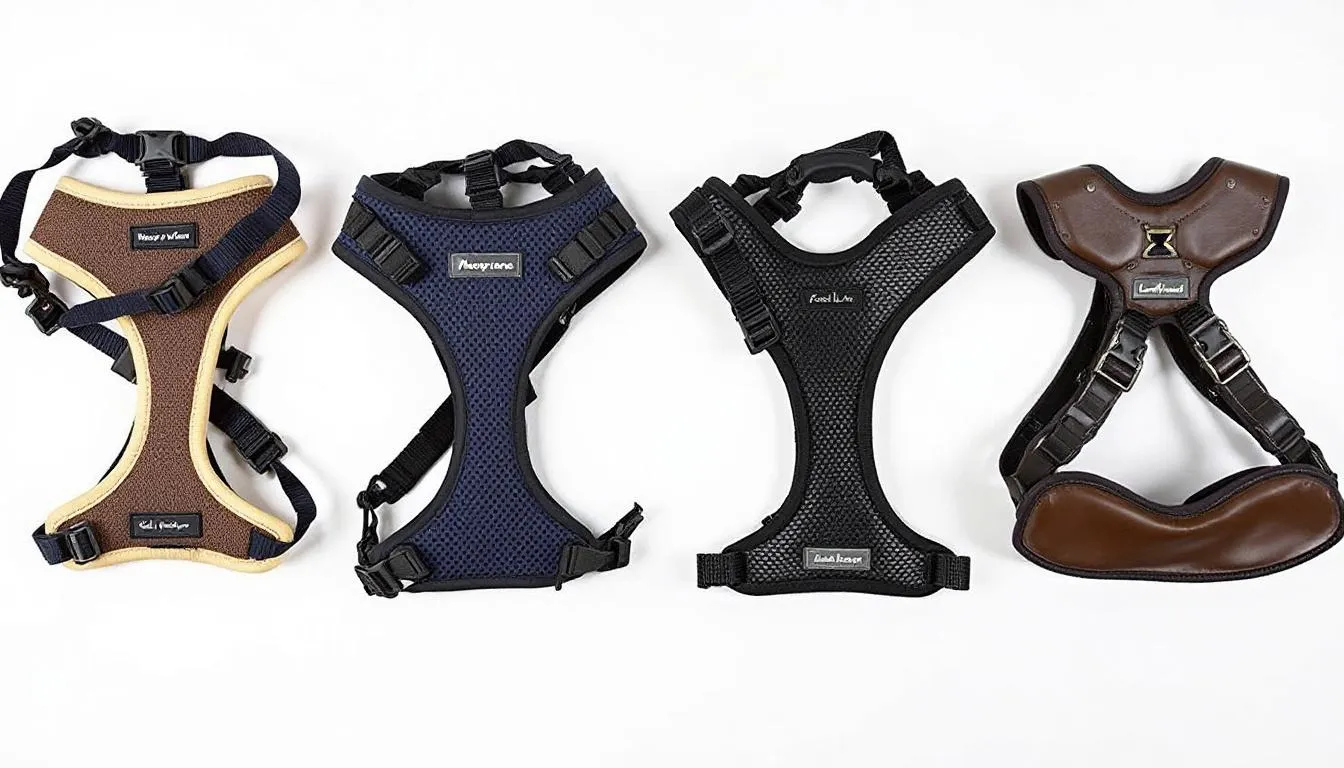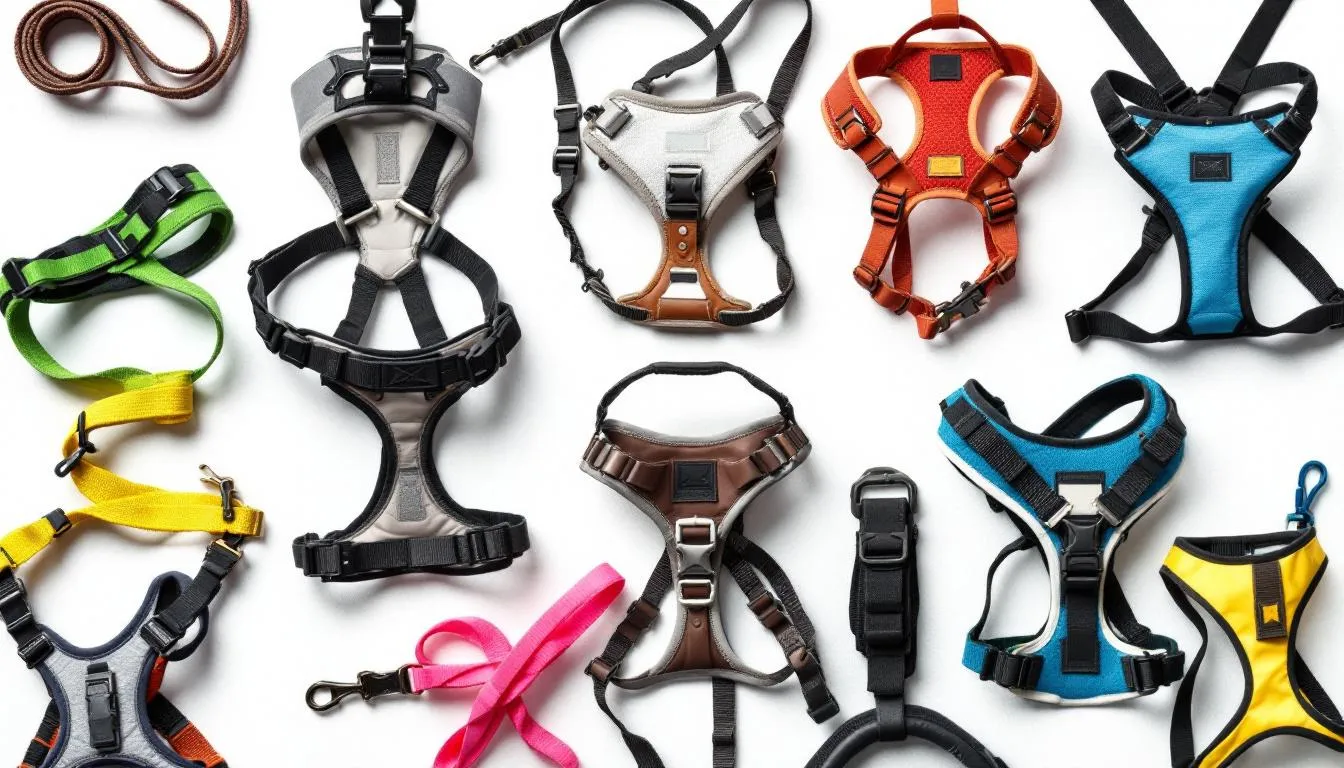

Key Takeaways
Dog chafing is skin irritation caused by friction from harnesses, collars, or body parts rubbing together
- Dog chafing is skin irritation caused by friction from harnesses, collars, or body parts rubbing together
- Immediate treatment involves removing the source of friction, cleaning the area, and applying soothing treatments like witch hazel or coconut oil
- Prevention requires proper-fitting equipment with padded materials and breathable fabrics
- Most chafing heals within 3-7 days with proper care, but persistent cases need veterinary attention
- Regular monitoring of your dog’s skin under equipment helps catch chafing early before it becomes severe
Immediate treatment involves removing the source of friction, cleaning the area, and applying soothing treatments like witch hazel or coconut oil
Prevention requires proper-fitting equipment with padded materials and breathable fabrics
Most chafing heals within 3-7 days with proper care, but persistent cases need veterinary attention
Regular monitoring of your dog’s skin under equipment helps catch chafing early before it becomes severe
When you notice your dog showing reluctance to wear their harness or discover red, irritated patches on their skin, you’re likely dealing with chafing. This common but often overlooked condition affects countless dogs and can quickly progress from minor irritation to painful, infected wounds if left untreated. Understanding how to identify, treat, and prevent chafing is essential for maintaining your dog’s comfort and preventing more serious skin complications.
Dog chafing represents one of the most preventable yet frequently encountered skin issues in pets. Whether your dog experiences mild redness after outdoor adventures or develops raw patches from ill-fitting equipment, prompt recognition and appropriate treatment can resolve most cases quickly and effectively.


What Is Dog Chafing and How to Identify It
Dog chafing occurs when repetitive friction caused by equipment or body movement creates skin irritation and damage. Unlike bacterial or yeast infections that develop from microorganisms, chafing results purely from mechanical rubbing that wears away the protective outer layer of your dog’s skin.
The condition commonly develops in specific locations where equipment contacts the body or where skin folds create natural friction points. Under harnesses, the armpits, chest, and back areas bear the brunt of movement-related rubbing. Around collar areas, the neck and behind the ears frequently show signs of irritation. Between skin folds, particularly in breeds with prominent wrinkles, moisture and movement combine to create ideal conditions for chafing to develop. Paws, especially after outdoor activities like walks or hikes, can also be affected by chafing and require protection to prevent dryness, cracking, or irritation on your dog's paws.
Visual signs of chafing follow a predictable pattern that mirrors equipment placement. Early stages present as redness and mild hair loss in areas where straps or buckles rest against the dog’s skin. As the condition progresses, you may notice raw patches, more extensive hair loss, and skin that appears thin or damaged. The affected skin often feels warm to the touch and may show signs of inflammation or swelling. Rashes can also develop as a result of chafing, and these rashes may require different treatment depending on their severity and underlying cause.
Behavioral indicators provide equally important clues about your dog’s discomfort. Dogs experiencing chafing often show reluctance to wear their regular equipment, may try to scratch or lick affected areas, and demonstrate clear discomfort when touched in irritated zones. Chafing can make dogs feel uncomfortable, leading to changes in their behavior. Some dogs become resistant to putting on harnesses or collars, while others may show changes in their walking gait or activity level.
Distinguishing chafing from other skin conditions requires understanding its unique characteristics. While yeast infections typically produce a musty odor and may appear moist or greasy, chafing creates dry, irritated patches with clear borders that match equipment contact points. Bacterial infections usually develop secondary to existing skin damage and may produce pus or crusty discharge, whereas simple chafing remains relatively clean unless secondary complications develop. Rashes can happen due to various causes such as allergies, parasites, or infections, so it's important to recognize when a rash is present and seek appropriate care.
Common Signs and Symptoms
Recognizing the early signs of harness chafing is essential for protecting your dog’s skin and overall comfort. The most common symptoms include redness, irritation, and visible discomfort in areas where the harness makes contact with the body. You may notice your dog scratching, licking, or biting at the affected skin, which can quickly lead to itchy skin, hair loss, or even raw patches if left unchecked. Dogs experiencing harness chafing might also seem restless or reluctant to wear their harness, especially after outdoor adventures.
Regularly inspecting your dog’s skin, particularly under the harness and around high-friction areas, helps catch minor issues before they escalate into more serious skin irritation. Look for any changes in the skin’s appearance, such as swelling, increased redness, or thinning hair, as these are early warning signs of chafing. Ensuring a proper harness fit and making it a habit to check your dog’s skin after walks or playtime can go a long way to prevent chafing and keep your dog happy and healthy.
Immediate Treatment Steps for Dog Chafing
When you discover chafing on your dog’s body, the first place to start is by identifying and removing the source of friction. Immediate action can prevent the condition from worsening and promote faster healing. The treatment process follows a systematic approach that addresses both the immediate irritation and the underlying cause.
In addition, some soothing treatments, such as coconut oil and witch hazel, are proven to help reduce inflammation and promote healing in chafed skin.
Remove the Source of Friction
The first and most critical step involves immediately removing the harness, collar, or clothing causing the chafing. Your dog’s skin needs time to breathe and begin its natural healing process without continued irritation from the offending equipment. Even properly fitted gear should be removed from affected areas until healing occurs.
If walks are necessary during the healing period, use alternative equipment that doesn’t put pressure on the chafed skin. A different style harness that contacts different areas of the dog’s body, a martingale collar for neck chafing, or even a head halter can provide temporary control while allowing damaged skin to recover.
Clean and Prepare the Affected Area
Gentle cleaning forms the foundation of effective chafing treatment. Use warm water and a soft, flat-textured cloth to carefully clean the area without causing additional irritation. Avoid harsh scrubbing or rough materials that could worsen the existing damage to your dog’s skin.
After cleaning, thoroughly dry the area to prevent moisture-related complications that can delay healing. Bacteria and yeast thrive in moist environments, so keeping the affected skin dry reduces the risk of secondary infections that could complicate recovery.
Inspect the area carefully for any signs of open wounds, bleeding, or infection. Document the extent of the damage with photos if possible, as this information can be valuable if veterinary consultation becomes necessary.
Apply Soothing Treatments
Several natural treatments can help soothe irritated skin and promote healing. Witch hazel offers anti-inflammatory benefits and can be applied directly to clean, intact skin using a soft cloth or cotton pad. Its astringent properties help reduce inflammation while promoting faster healing of damaged tissue.
Coconut oil serves as an excellent natural alternative for treating chafed skin. Apply a thin layer in the evening to avoid dirt adhesion during daytime activities. The oil’s antimicrobial properties help prevent bacterial overgrowth while providing moisture and protection to healing skin.
Aloe vera gel provides additional soothing properties for inflamed skin. Choose pure aloe vera without added fragrances or chemicals that could cause further irritation. Apply sparingly to avoid creating a moist environment that might encourage bacterial growth.
Avoid petroleum-based products like Vaseline, which can be harmful if ingested and may trap dirt and debris against the healing skin. These products aren’t designed for canine use and can actually delay healing in some cases.
Dog’s Rash: Recognizing Related Skin Issues
A dog’s rash can sometimes be mistaken for or occur alongside harness chafing, making it important to recognize the difference and address any underlying causes. Skin irritation from harness chafing may open the door to other issues, such as yeast infections or dry skin, which can further aggravate the affected skin. If you notice persistent redness, bumps, or a rash that doesn’t improve with basic care, it’s essential to consult your vet for a proper diagnosis and treatment plan.
In some cases, soothing remedies like coconut oil or vitamin E can help calm irritated skin, but always check with your vet before applying any medications or supplements to your dog’s rash. Identifying other factors—such as allergies, environmental irritants, or underlying infections—can be crucial for effective treatment and long-term prevention. Regularly checking both your dog’s skin and the condition of their harness is essential to prevent chafing and related skin issues, ensuring your dog’s well-being and comfort.


Root Causes of Dog Chafing
Understanding why chafing develops helps prevent future occurrences and guides equipment selection. Multiple factors contribute to friction-related skin damage, often working in combination to create problematic conditions.
To minimize the risk, regularly check both your dog's skin and equipment for early signs of chafing or irritation.
Equipment-Related Causes
Ill-fitting harnesses represent the most common cause of chafing in dogs. Equipment that’s too tight creates constant pressure against the skin, while loose-fitting gear shifts and rubs with each movement. Poor positioning of straps can concentrate pressure on sensitive areas like the armpits or create friction points that weren’t intended by the manufacturer.
The material composition of equipment significantly affects chafing risk. Rough or non-breathable fabrics increase friction and trap moisture against the dog’s skin. Worn-out equipment with frayed edges or damaged padding can create sharp contact points that quickly damage delicate skin tissue.
Incorrectly adjusted straps create localized pressure points that concentrate force on small areas of skin. Even high-quality equipment can cause problems if the fit isn’t customized to your individual dog’s body shape and size.
Dog-Specific Risk Factors
High activity levels increase both the duration and intensity of friction between equipment and skin. Dogs that engage in vigorous exercise, running, or prolonged outdoor adventures generate more movement and friction in contact zones, making chafing more likely even with properly fitted gear.
Certain body conformations create natural predispositions to chafing. Dogs with prominent skin folds, sensitive skin areas, or unusual body proportions may require specialized equipment or extra attention to prevent friction-related problems.
Coat type and density affect how equipment sits against the skin and influences moisture retention. Long-haired breeds may experience matting under equipment that creates additional friction, while short-haired dogs have less natural padding between their skin and gear.
Environmental Contributors
Hot and humid weather increases moisture under equipment, softening the skin and making it more susceptible to friction damage. Sweat and humidity create ideal conditions for chafing to develop quickly, particularly during extended outdoor activities.
Dirt and debris that accumulate between skin and gear act like sandpaper, increasing the abrasive effects of normal movement. Regular equipment cleaning becomes essential in dusty or dirty environments where particles can contribute to skin irritation.
Extended wear periods without breaks don’t allow skin to breathe and recover from friction pressure. Even well-fitted equipment needs periodic removal to prevent cumulative damage from constant contact.
Swimming or rain create wet conditions that soften the skin’s protective barrier, making it more vulnerable to friction damage. Wet equipment also tends to shift more against the skin, increasing the likelihood of chafing development.
Activity Level and Its Impact
Your dog’s activity level plays a significant role in the likelihood of developing harness chafing. Dogs that are highly active or enjoy frequent outdoor adventures are more prone to chafing, as increased movement can cause the harness to rub against the skin, leading to irritation and discomfort. The friction caused by a poorly fitting harness or lack of padding can quickly turn minor rubbing into a more serious skin issue.
To prevent chafing in active dogs, it’s essential to choose a harness with adequate padding and ensure a proper fit that allows for natural movement without excessive rubbing. Regularly inspect both the harness and your dog’s skin, especially after periods of high activity, to catch any early signs of irritation. Adjusting the harness as needed and giving your dog breaks from wearing it can help reduce the risk of chafing. By considering your dog’s activity level and taking these preventive steps, you can help keep your dog’s skin healthy and ensure their comfort during every adventure.


Prevention Strategies and Best Practices
Preventing chafing requires a proactive approach that addresses equipment selection, proper fitting, and ongoing maintenance. Most chafing cases can be avoided entirely with careful attention to these preventive measures. Prevention strategies should also include protecting your dog's paws, especially during walks or hikes, as paws are prone to chafing, cracking, and dryness from outdoor activities.
Choosing the Right Equipment
Selecting appropriate harnesses and collars starts with understanding your dog’s specific needs and body type. Look for equipment with adequate padding in high-friction areas, particularly around the chest, armpits, and anywhere straps contact the skin directly.
Choose breathable, soft materials like mesh or padded neoprene that reduce friction while allowing air circulation. These materials help prevent the moisture buildup that contributes to skin softening and increased chafing risk.
Ensure the equipment offers proper sizing options with adjustable straps for a custom fit. Generic sizing often doesn’t account for individual variations in body shape, chest depth, or neck circumference that affect how equipment sits against your dog’s skin.
Look for smooth seams and rounded edges that minimize abrasion potential. Rough edges, prominent stitching, or sharp hardware can create focused pressure points that quickly damage skin tissue.
Proper Fitting and Adjustment
The two-finger rule provides a reliable guideline for achieving proper equipment fit. You should be able to slip two fingers comfortably between your dog’s skin and any strap or collar, ensuring adequate room for movement without excessive looseness.
Regular fit checks become essential as dogs grow, gain or lose weight, or experience seasonal coat changes. What fits perfectly in winter may be too tight when summer brings a thinner coat, while growing puppies need frequent adjustments to maintain proper spacing.
Proper positioning prevents equipment from sitting on sensitive areas or creating unnatural pressure points. Harnesses should distribute weight across the chest rather than concentrating force on the neck or armpits.
Seasonal adjustments account for coat length changes that affect equipment fit. Many dogs need different sizing or strap positions between their full winter coat and summer trim.
Maintenance and Monitoring
Daily skin checks after removing equipment allow early detection of any irritation before it progresses to painful chafing. Look for redness, hair loss, or any changes in skin texture that might indicate developing problems.
Regular cleaning of harnesses and collars prevents bacteria buildup and removes dirt particles that contribute to abrasion. Clean equipment also maintains its intended texture and padding properties.
Rotating between different pieces of equipment helps vary pressure points and prevents cumulative damage from constant contact in the same areas. Having multiple harnesses or collars allows each piece to dry thoroughly between uses.
Replace worn equipment before it causes skin damage. Frayed edges, compressed padding, or stretched straps indicate it’s time for new gear, even if the equipment still functions for restraint purposes.
When to Seek Veterinary Care
While most cases of dog chafing respond well to home treatment, certain signs indicate the need for professional veterinary attention. Recognizing these red flags helps prevent minor issues from developing into serious medical problems.
Chafing that doesn’t show improvement within 3-7 days of proper treatment may indicate underlying factors that require professional assessment. Persistent irritation could suggest allergic reactions, deeper tissue damage, or other factors that complicate healing. If your dog develops a rash or if rashes persist despite home treatment, veterinary consultation is necessary.
Open wounds, bleeding, or signs of secondary infection require immediate veterinary care. These complications can develop quickly and may need prescription medications to resolve safely.
Excessive swelling, pus formation, or foul odor from affected areas suggests bacterial infection that won’t respond to home treatment alone. These signs indicate the need for professional diagnosis and likely antibiotic treatment.
Behavioral changes indicating severe pain or discomfort warrant professional evaluation. Dogs that become aggressive when touched, show significant changes in appetite or activity, or demonstrate obvious distress need veterinary assessment.
Recurring chafing despite preventive measures may indicate underlying skin conditions, allergies, or anatomical factors that require professional management. Underlying conditions may present as rashes, and a vet can help diagnose the cause of your dog's rash and develop a comprehensive treatment plan.
Most cases of simple chafing resolve quickly with appropriate care, but don’t hesitate to seek professional help when home treatment isn’t providing expected results.


Special Considerations for Different Dog Breeds
Different dog breeds present unique challenges and considerations when it comes to preventing and treating chafing. Understanding breed-specific factors helps tailor your approach to your individual dog’s needs.
Brachycephalic breeds like bulldogs, pugs, and French bulldogs have unique neck and chest proportions that affect equipment fit. Their shortened airways and broad chests require carefully selected harnesses that don’t compress the throat or chest area while still providing adequate control.
Long-haired breeds require extra attention to prevent matting under equipment that can create additional friction points. Regular brushing under harness areas and ensuring equipment doesn’t compress or tangle the coat helps prevent complications that contribute to chafing.
Giant breeds need heavy-duty equipment that properly distributes weight and pressure across their larger frame. Standard equipment may concentrate too much force on specific areas, leading to pressure sores and chafing in dogs over 100 pounds.
Small breeds often have delicate skin that requires extra-soft materials and careful attention to equipment weight. Heavy hardware or thick straps can overwhelm a small dog’s frame and create disproportionate pressure on their tiny body.
Working dogs with extended equipment wear need specialized gear designed for durability and comfort during long periods of use. Police dogs, service dogs, and other working animals require equipment that maintains comfort and function throughout extended shifts.
Understanding your dog’s specific breed characteristics helps guide equipment selection and fitting decisions that reduce chafing risk while meeting your dog’s functional needs.
FAQ
How long does it take for dog chafing to heal completely?
Most minor chafing heals within 3-7 days with proper care and removal of the friction source. Severe cases with open wounds may take 1-2 weeks. Hair regrowth in affected areas can take several weeks to months depending on the extent of damage. The healing timeline depends on the severity of the initial injury, your dog’s overall health, and how consistently you follow treatment protocols.
Can I use human products like Neosporin on my dog’s chafed skin?
Avoid using human medications on dogs without veterinary approval. Neosporin contains ingredients that can be toxic if ingested by dogs. Many human topical products contain harmful ingredients that aren’t safe for pets who tend to lick treated areas. Stick to dog-safe alternatives like coconut oil, witch hazel, or products specifically designed for canine skin care.
Is it safe to continue walks while my dog’s skin is healing from chafing?
Yes, but use alternative equipment that doesn’t put pressure on the healing area. Consider a different style harness, a martingale collar, or even a head halter temporarily. Keep walks shorter and avoid activities that increase friction until the skin fully heals. Your dog’s comfort and well being should take priority over maintaining normal exercise routines during recovery.
Why does my dog’s chafing keep coming back even with a properly fitted harness?
Recurring chafing may indicate underlying skin sensitivities, allergies, or medical conditions that make the skin more prone to irritation. Some dogs have naturally sensitive skin that requires extra-soft materials, frequent equipment rotation, or specialized protective barriers. Other factors like dry skin, vitamin deficiencies, or hormonal imbalances can affect skin health and healing. Consult your vet if chafing persists despite proper equipment and care.
Should I be concerned if the chafed area looks darker after healing?
Mild hyperpigmentation (darkening) is normal during the healing process and usually fades over time. However, if the area remains significantly darker, develops a rough texture, or shows signs of infection, consult your veterinarian as this could indicate deeper tissue damage or secondary complications. Document changes with photos to help your vet assess whether the healing is progressing normally.
FAQ
How long does it take for dog chafing to heal completely?
Most minor chafing heals within 3-7 days with proper care and removal of the friction source. Severe cases with open wounds may take 1-2 weeks. Hair regrowth in affected areas can take several weeks to months depending on the extent of damage. The healing timeline depends on the severity of the initial injury, your dog’s overall health, and how consistently you follow treatment protocols.
Can I use human products like Neosporin on my dog’s chafed skin?
Avoid using human medications on dogs without veterinary approval. Neosporin contains ingredients that can be toxic if ingested by dogs. Many human topical products contain harmful ingredients that aren’t safe for pets who tend to lick treated areas. Stick to dog-safe alternatives like coconut oil, witch hazel, or products specifically designed for canine skin care.
Is it safe to continue walks while my dog’s skin is healing from chafing?
Yes, but use alternative equipment that doesn’t put pressure on the healing area. Consider a different style harness, a martingale collar, or even a head halter temporarily. Keep walks shorter and avoid activities that increase friction until the skin fully heals. Your dog’s comfort and well being should take priority over maintaining normal exercise routines during recovery.
Why does my dog’s chafing keep coming back even with a properly fitted harness?
Recurring chafing may indicate underlying skin sensitivities, allergies, or medical conditions that make the skin more prone to irritation. Some dogs have naturally sensitive skin that requires extra-soft materials, frequent equipment rotation, or specialized protective barriers. Other factors like dry skin, vitamin deficiencies, or hormonal imbalances can affect skin health and healing. Consult your vet if chafing persists despite proper equipment and care.
Should I be concerned if the chafed area looks darker after healing?
Mild hyperpigmentation (darkening) is normal during the healing process and usually fades over time. However, if the area remains significantly darker, develops a rough texture, or shows signs of infection, consult your veterinarian as this could indicate deeper tissue damage or secondary complications. Document changes with photos to help your vet assess whether the healing is progressing normally.






